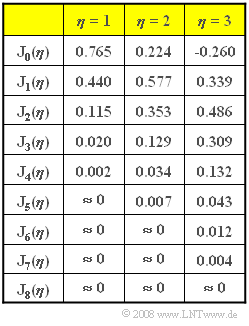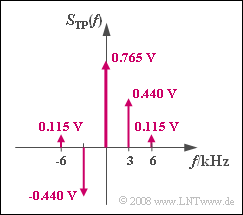Difference between revisions of "Aufgaben:Exercise 3.2: Spectrum with Angle Modulation"
m |
m (→Solution) |
||
| Line 73: | Line 73: | ||
===Solution=== | ===Solution=== | ||
{{ML-Kopf}} | {{ML-Kopf}} | ||
| − | '''(1)''' | + | '''(1)''' The phase $ϕ(t)$ is proportional to the source signal $q(t)$ ⇒ this is a phase modulation ⇒ <u>Answer 2</u>. |
| − | '''(2)''' | + | '''(2)''' An angle modulationn (PM, FM) always results in nonlinear distortion when the channel is bandlimited. |
| − | * | + | *In contrast, double-sideband amplitude modulation (DSB-AM) here enables distortion-free transmission with $B_{\rm K} = 6 \ \rm kHz$ ; ⇒ <u>Answer 1</u>. |
| − | '''(3)''' | + | '''(3)''' The modulation index (or phase deviation) is equal to $η = K_{\rm M} · A_{\rm N}$ for phase modulation. |
| − | * | + | *Thus, the modulator constant must be set to $K_{\rm M} = 1/A_{\rm N}\hspace{0.15cm}\underline { = 0.5 \rm \cdot {1}/{V}}$ to give $η = 1$ . |
| − | '''(4)''' | + | '''(4)''' A so-called Bessel spectrum is present: |
:$$ S_{\rm TP}(f) = A_{\rm T} \cdot \sum_{n = - \infty}^{+\infty}{\rm J}_n (\eta) \cdot \delta (f - n \cdot f_{\rm N})\hspace{0.05cm}.$$ | :$$ S_{\rm TP}(f) = A_{\rm T} \cdot \sum_{n = - \infty}^{+\infty}{\rm J}_n (\eta) \cdot \delta (f - n \cdot f_{\rm N})\hspace{0.05cm}.$$ | ||
| − | * | + | *This is a discrete spectrum with components at $f = n · f_{\rm N}$, where $n$ is an integer. |
| − | * | + | *The weights of the Dirac functions are given by the Bessel functions. When $A_{\rm T} = 1\ \rm V$ , one obtains: |
| − | [[File:P_ID1082__Mod_A_3_2_d.png|right|frame| | + | [[File:P_ID1082__Mod_A_3_2_d.png|right|frame|PM spectrum in the equivalent low-pass range]] |
:$$ S_{\rm TP}(f = 0) = A_{\rm T} \cdot {\rm J}_0 (\eta = 1) \hspace{0.15cm}\underline {= 0.765\,{\rm V}},$$ | :$$ S_{\rm TP}(f = 0) = A_{\rm T} \cdot {\rm J}_0 (\eta = 1) \hspace{0.15cm}\underline {= 0.765\,{\rm V}},$$ | ||
:$$ S_{\rm TP}(f = f_{\rm N}) = A_{\rm T} \cdot {\rm J}_1 (\eta = 1)\hspace{0.15cm} = 0.440\,{\rm V},$$ | :$$ S_{\rm TP}(f = f_{\rm N}) = A_{\rm T} \cdot {\rm J}_1 (\eta = 1)\hspace{0.15cm} = 0.440\,{\rm V},$$ | ||
:$$ S_{\rm TP}(f = 2 \cdot f_{\rm N}) = A_{\rm T} \cdot {\rm J}_2 (\eta = 1) = 0.115\,{\rm V} \hspace{0.05cm}.$$ | :$$ S_{\rm TP}(f = 2 \cdot f_{\rm N}) = A_{\rm T} \cdot {\rm J}_2 (\eta = 1) = 0.115\,{\rm V} \hspace{0.05cm}.$$ | ||
| − | * | + | *Due to the symmetry ${\rm J}_{-n} (\eta) = (-1)^n \cdot {\rm J}_{n} (\eta)$ , the spectral line at $f = -3 \ \rm kHz$ is obtained as: |
:$$S_{\rm TP}(f = -f_{\rm N}) = -S_{\rm TP}(f = +f_{\rm N}) =\hspace{-0.01cm}\underline { -0.440\,{\rm V} \hspace{0.05cm}}.$$ | :$$S_{\rm TP}(f = -f_{\rm N}) = -S_{\rm TP}(f = +f_{\rm N}) =\hspace{-0.01cm}\underline { -0.440\,{\rm V} \hspace{0.05cm}}.$$ | ||
| − | '' | + | ''Note'': For the spectral value at $f = 0$ we should actually write: |
:$$S_{\rm TP}(f = 0) = 0.765\,{\rm V} \cdot \delta (f) \hspace{0.05cm}.$$ | :$$S_{\rm TP}(f = 0) = 0.765\,{\rm V} \cdot \delta (f) \hspace{0.05cm}.$$ | ||
| − | * | + | *This is therefore infinite due to the Dirac function, and only the weight of the Dirac function is finite. |
| − | * | + | *The same applies for all discrete spectral line. |
Revision as of 14:52, 14 March 2022
The following equations are assumed here:
- Source signal:
- $$q(t) = 2\,{\rm V} \cdot \sin(2 \pi \cdot 3\,{\rm kHz} \cdot t)\hspace{0.05cm},$$
- Transmit signal:
- $$s(t) = 1\,{\rm V} \cdot \cos\hspace{-0.1cm}\big[2 \pi \cdot 100\,{\rm kHz} \cdot t + K_{\rm M} \cdot q(t)\big ]\hspace{0.05cm},$$
- Received signal (ideal channel):
- $$r(t) = s(t) = 1\,{\rm V} \cdot \cos\hspace{-0.1cm}\big[2 \pi \cdot 100\,{\rm kHz} \cdot t + \phi(t)\big ]\hspace{0.05cm},$$
- ideal demodulator:
- $$ v(t) = \frac{1}{ K_{\rm M}} \cdot \phi(t)\hspace{0.05cm}.$$
The graphs shows the $n$–th order Bessel functions of the first kind ${\rm J}_n (\eta)$ in table form.
Hints:
- This exercise belongs to the chapter Phase Modulation.
- Particular reference is made to the pages Spectral function of a phase-modulated sine signal and Interpretation of the Bessel spectrum.
Questions
Solution
(2) An angle modulationn (PM, FM) always results in nonlinear distortion when the channel is bandlimited.
- In contrast, double-sideband amplitude modulation (DSB-AM) here enables distortion-free transmission with $B_{\rm K} = 6 \ \rm kHz$ ; ⇒ Answer 1.
(3) The modulation index (or phase deviation) is equal to $η = K_{\rm M} · A_{\rm N}$ for phase modulation.
- Thus, the modulator constant must be set to $K_{\rm M} = 1/A_{\rm N}\hspace{0.15cm}\underline { = 0.5 \rm \cdot {1}/{V}}$ to give $η = 1$ .
(4) A so-called Bessel spectrum is present:
- $$ S_{\rm TP}(f) = A_{\rm T} \cdot \sum_{n = - \infty}^{+\infty}{\rm J}_n (\eta) \cdot \delta (f - n \cdot f_{\rm N})\hspace{0.05cm}.$$
- This is a discrete spectrum with components at $f = n · f_{\rm N}$, where $n$ is an integer.
- The weights of the Dirac functions are given by the Bessel functions. When $A_{\rm T} = 1\ \rm V$ , one obtains:
- $$ S_{\rm TP}(f = 0) = A_{\rm T} \cdot {\rm J}_0 (\eta = 1) \hspace{0.15cm}\underline {= 0.765\,{\rm V}},$$
- $$ S_{\rm TP}(f = f_{\rm N}) = A_{\rm T} \cdot {\rm J}_1 (\eta = 1)\hspace{0.15cm} = 0.440\,{\rm V},$$
- $$ S_{\rm TP}(f = 2 \cdot f_{\rm N}) = A_{\rm T} \cdot {\rm J}_2 (\eta = 1) = 0.115\,{\rm V} \hspace{0.05cm}.$$
- Due to the symmetry ${\rm J}_{-n} (\eta) = (-1)^n \cdot {\rm J}_{n} (\eta)$ , the spectral line at $f = -3 \ \rm kHz$ is obtained as:
- $$S_{\rm TP}(f = -f_{\rm N}) = -S_{\rm TP}(f = +f_{\rm N}) =\hspace{-0.01cm}\underline { -0.440\,{\rm V} \hspace{0.05cm}}.$$
Note: For the spectral value at $f = 0$ we should actually write:
- $$S_{\rm TP}(f = 0) = 0.765\,{\rm V} \cdot \delta (f) \hspace{0.05cm}.$$
- This is therefore infinite due to the Dirac function, and only the weight of the Dirac function is finite.
- The same applies for all discrete spectral line.
(5) $S_+(f)$ ergibt sich aus $S_{\rm TP}(f)$ durch Verschiebung um $f_{\rm T}$ nach rechts. Deshalb ist
- $$S_{\rm +}(f = 97\,{\rm kHz}) = S_{\rm TP}(f = -3\,{\rm kHz}) \hspace{0.15cm}\underline {=-0.440\,{\rm V}} \hspace{0.05cm}.$$
- Das tatsächliche Spektrum unterscheidet sich von $S_+(f)$ bei positiven Frequenzen um den Faktor $1/2$:
- $$S(f = 97\,{\rm kHz}) = {1}/{2} \cdot S_{\rm +}(f = 97\,{\rm kHz}) \hspace{0.15cm}\underline {=-0.220\,{\rm V}} \hspace{0.05cm}.$$
- Allgemein kann geschrieben werden:
- $$ S(f) = \frac{A_{\rm T}}{2} \cdot \sum_{n = - \infty}^{+\infty}{\rm J}_n (\eta) \cdot \delta (f \pm (f_{\rm T}+ n \cdot f_{\rm N}))\hspace{0.05cm}.$$
(6) Unter der vorgeschlagenen Vernachlässigung können alle Bessellinien ${\rm J}_{|n|>3}$ außer Acht gelassen werden.
- Damit erhält man $B_{\rm K} = 2 · 3 · f_{\rm N}\hspace{0.15cm}\underline { = 18 \ \rm kHz}$.
(7) Die Zahlenwerte in der Tabelle auf der Angabenseite zeigen, dass nun folgende Kanalbandbreiten erforderlich wären:
- für $η = 2$: $B_{\rm K} \hspace{0.15cm}\underline { = 24 \ \rm kHz}$,
- für $η = 3$: $B_{\rm K} \hspace{0.15cm}\underline { = 36 \ \rm kHz}$.

